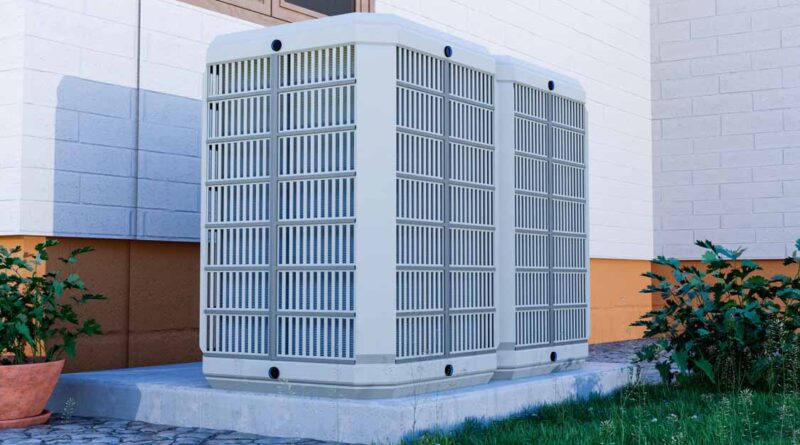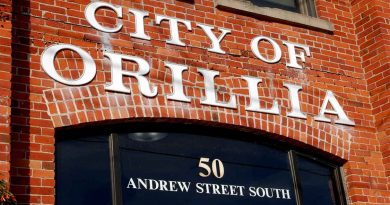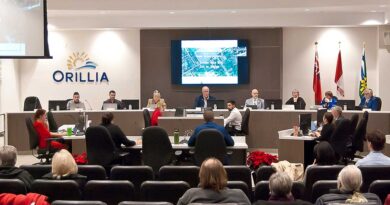The Heat Pump Experience, So Far
By Gord Ball – Special to SUNonline/Orillia
What if you could save up to $1,000 per year or more on the cost of heating and cooling your home, while also helping the planet? You can—with a new cold climate heat pump.
What’s not to like about lower utility bills and reduced carbon emissions? With new rebates, mandates, and tax credits, heat pump sales are taking off. High demand is expected to drive sales through the roof by the end of the decade. More and more Canadian households are saying goodbye to an oil or natural gas furnace and hello to a heat pump. Many municipalities are supporting building codes that require the use of heat pumps in new homes and new construction. New York State is the first jurisdiction in the USA to ban gas hook-ups in new buildings.
The Canadian Climate Institute prepared a recent report on the costs of various home heating and cooling technologies. It found heat pumps are the lowest-cost option in two-thirds of all cases they considered, using conservative estimates for gas and electricity prices. They’re most popular in places like Vancouver, Toronto, Montreal and Halifax where single-family homes and townhouses (both old and newer construction) lean decisively in favour of heat pumps. Heat pumps are the top solution recommended for our buildings by the International Panel of Climate Change (IPCC) and most climate action plans because they are most efficient, are an economical and proven technology, and can reduce emissions by 35-45% in Ontario.
Heat pumps move heat. They don’t create it. A heat pump amplifies and transfers outside heat into a home, and because the heat is from an already existing source and not being generated, these systems are more energy efficient than fossil fuel systems. A heat pump works efficiently by injecting a small amount of heat over a long period. Even in winter, a heat pump magically pulls heat out of nearby outside air and uses it to heat buildings. It can even heat water. A heat pump is able to both cool and heat a home with a single system. In the summer it simply works in reverse, transferring heat out of the house and into the air.
Sustainable Orillia interviewed two new heat pump owners in Orillia. Donna Gowland and Jim McMahon of Moon Point Drive made the change.
“We had no choice,” Donna said. “We were on oil heat. Our oil tank was over 20 years old, and they wouldn’t fill it unless we replaced it. Our furnace was old, too. That forced our hand. We started out by getting estimates on natural gas furnaces. In the end, we went all-in. We got a heat pump as well as a heat pump water heater, had natural gas installed to back up the heat pump, and will have a Generac (backup power) installed shortly.”
Donna and Jim remembered the ice storm and didn’t want to depend on any single source for heat. “Gas prices can go crazy. Now we can switch between sources, electricity and gas.
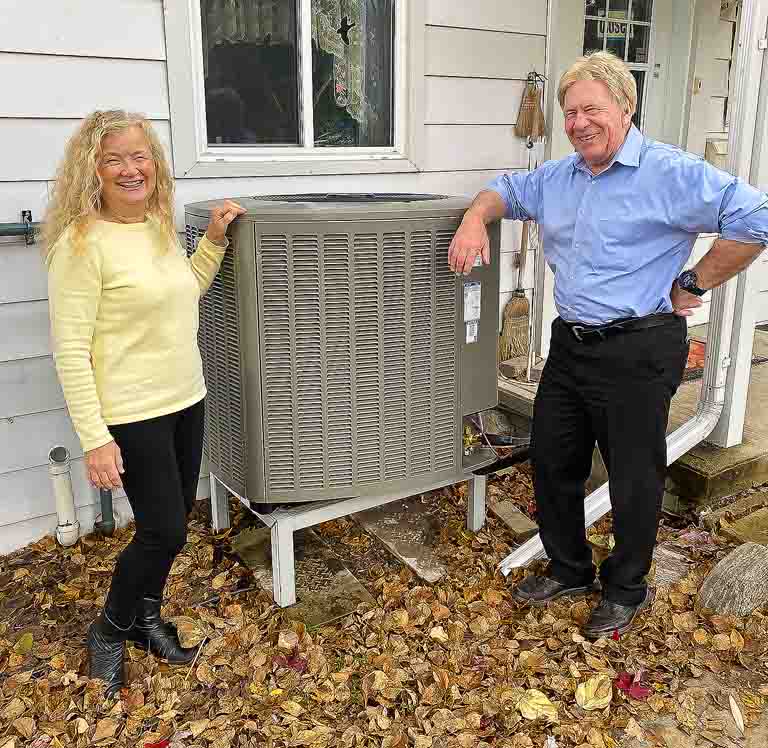
“We had six contractors give us estimates. They had different stories and made different claims. Finally we called an authorized Trane dealer who also represented Lennox, and he actually recommended Lennox for this neck of the woods. Talking with the contractors, we learned that access to parts is important. Lennox has a large warehouse of parts near Barrie and is highly rated among the frontline Ontario service people. Our new heat pump is keeping us warm now. Of course it runs more often as it gets colder outside, but it’s quiet. We just don’t know enough yet to stand by the colder weather temperature predictions.”
The cost? Their cheapest estimate was $8,000 and the most expensive was $13,000. “We also had to buy heavier wiring and a new circuit breaker, plus the cost of an electrician. Consumer Reports gave us some helpful advice. The federal rebate is an incentive, but it does need some work.”
In addition to the federal rebate, Ontario is now offering free cold-climate air-source heat pumps (ASHP) to income-eligible households which currently have electric baseboard heating. According to the province’s Save On Energy program, switching from electric baseboard heaters to a cold climate ASHP can reduce resident’s electricity bills by up to 50%. However, homes that are heated with propane, fuel oil or fossil gas do not qualify. (The emission reduction logic behind helping only those people who are currently reliant on electric heating is not clear.)
Donna and Jim recommend talking to somebody who’s been through the installation. “It’s so new,” says Donna. “We’re learning and so are the installers. Do your own research, your homework. You can’t count on the installer to tell you everything you need to know.” Do Donna and Jim have any regrets so far?
“We were extremely lucky to find a good contractor. We would work with the same company again. They were exceedingly conscientious. But it is all new. We’re hoping that it turns out that we made the best decision. We can let you know in the spring. We just don’t know enough yet to stand by the colder weather temperature predictions and claims.”
A major concern for Donna and Jim was the confusion of information they receive at different times during the process – about the efficiency of the heat pump in cold weather.
The literature said it was good to minus 25, but by the time the installation was finished, they had received figures of minus 25, minus 21, minus 15 and minus 10. When finished the work, their installer set the gas furnace to come on at minus 4, a figure well above what manufacturers recommend.
“In doing our homework we ran smack into contradictions, disinformation or misinformation, and certainly misleading information, and we still don’t know for sure what to believe. Others will run into this, too.”
It would appear that there is uncertainty about heat pumps even among installers. One also can’t be sure whether the range in temperatures is part of the sales pitch for the backup gas furnace or simply a result of the installer’s inexperience with heat pumps, leading to a recommendation of a setting on the safe side. This problem should sort itself out as customers, installers and manufacturers gain more experience with the effectiveness of heat pumps across our area. Remember, though, the output of the air source heat pump is dependent on how cold the winter temperatures get.
One hopeful sign is similarly cold countries like Norway, Finland and Sweden have the most heat pumps per capita. While fossil fuel supporters and naysayers often say heat pumps don’t work in cold places, the people in Nordic countries have already made their choice. An article entitled Heat Pumps: How Norwegians Pay Less for Heating, notes the following: “The heat pumps we are talking about in this article, that are so massively popular in Norway, are air source heat pumps: cheaper to install and still much more efficient than traditional electric heating… Today, about half of Norwegian households have heat pumps installed.”
Technological advances mean modern heat pumps work well in cold climates and old buildings. “We’ve had our heat pump only since mid-September so we haven’t yet had a lot of experience with its performance in cold weather. We’ll be happy to have that discussion at the end of the winter,” said Donna. Some of their neighbours had older models that weren’t up to Orillia’s cold weather. “We’re banking on the new heat pumps geared for cold weather.”
Mark and Sandi Bisset of Orillia have also recently installed a heat pump in their home. “We love it so far,” said Mark. “We haven’t got any complaints. It’s wonderfully quiet – quieter than I expected it to be. So far, everything’s working well.”
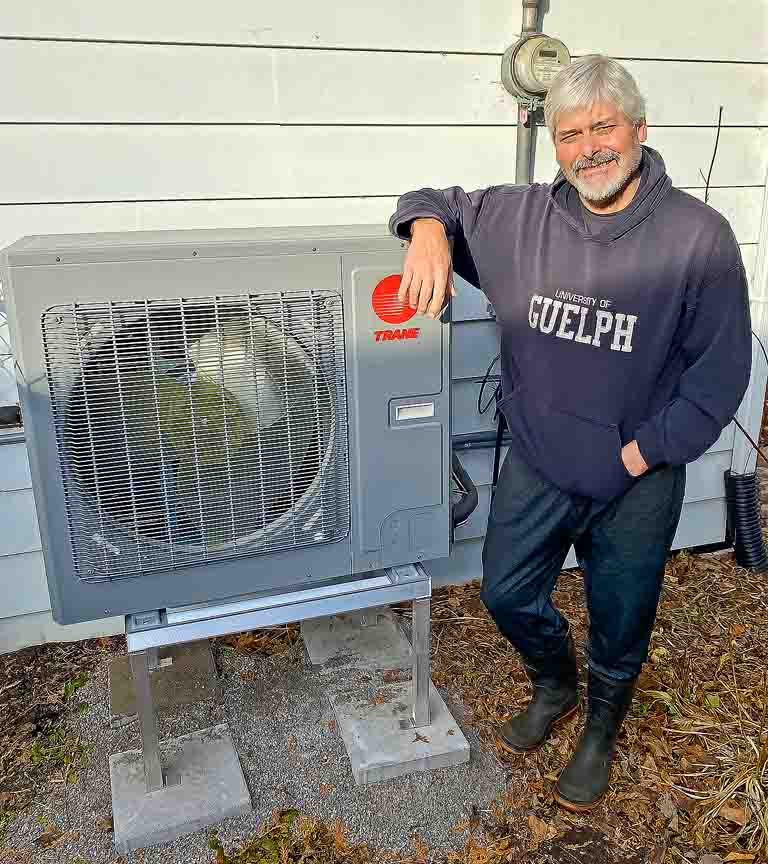
Why did they switch to a heat pump? “We’ve gradually been electrifying our life,” said Mark. “It started with a lawnmower. Back in the late ‘90s, we bought an electric lawnmower. I was tired of keeping my stupid gas lawnmower running. The electric lawnmower was expensive and it didn’t work very well. But since then batteries have improved a lot and we’re very happy with our new electric lawnmower.”
That lawnmower was followed by an electric outboard 3.5 HP motor for their sailboat. “It was a great success too,” said Mark. “Those two experiences kept us moving in the electric direction.”
Mark and Sandi’s 25-year-old furnace was near the end of its life, and so they started looking at electric heat pumps. Their modest-sized house, with good insulation, was a good candidate. They chose a heat pump that works in temperatures as low as -30C. In addition, they had never had air conditioning but wanted to install AC after a few recent super-heated summers. The heat pump was their answer to both heating and cooling.
They began with the Enertest audit of their house, costing around $600 (reimbursed once the system is approved and installed). “In the end,” Mark said, “we went with a Trane XL824 high-efficiency unit. We decided to go with an electric, premium heat pump, eliminating gas entirely from our heating system.”
Mark began by consulting the original installer of their gas furnace, but he had not installed any heat pumps. So Mark followed up with an Internet search, made inquiries and ended up going with CGS HVAC Inc. “We wanted a certified, experienced installer who was local and would be responsive if there was a problem. It took about three days to install both the outside and inside units.”The system ended up costing $16,645 all in. “It’s a premium system,” said Mark. “That heat pump qualified us for a $6,500 rebate.”
The federal government’s $2.6-billion Canada Greener Homes Grant can help reduce the purchase price by $5,000, while other provincial, municipal and utility rebates in parts of the country will cut installation costs even further. About 40,000 heat pumps have been installed or approved as part of the federal government’s Canada Greener Homes Grant, launched in 2021.
Some contractors may claim heat pumps don’t work well in Orillia’s climate and are still interested in installing gas equipment. But, there are an increasing number of installers experienced in heat pumps. Peter Messenger, an Oakville, Ontario HVAC specialist, says heat pumps have gone from 10 percent of his company’s business to about half, almost overnight. The supply chain problems of recent years no longer exist. There is a growing familiarity with the technology, installers say, and a growing interest by homeowners in both saving money and reducing their environmental footprint.
“I’m surprised at how quickly the general public’s mindset has changed on heat pumps,” says Messenger. “I always knew it would happen. I just didn’t know it would happen this quickly.”
(Images Supplied) Main: Heat Pump (Image by freepik.com)

